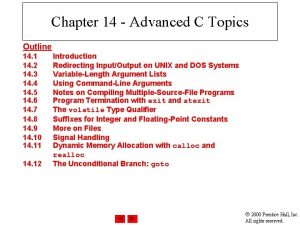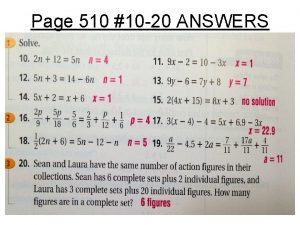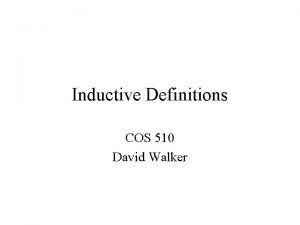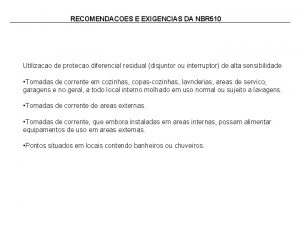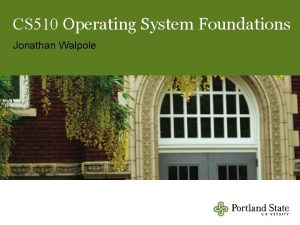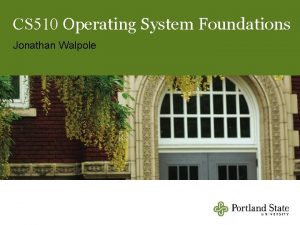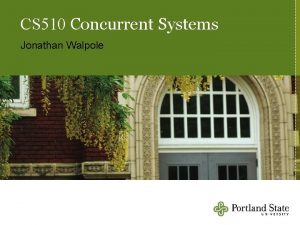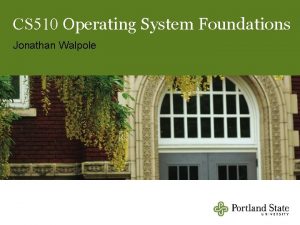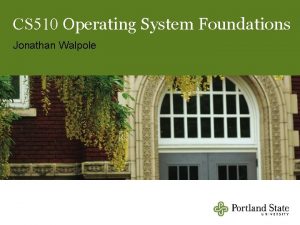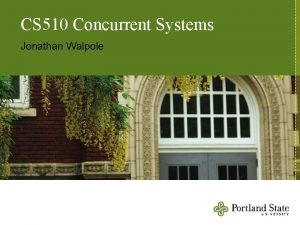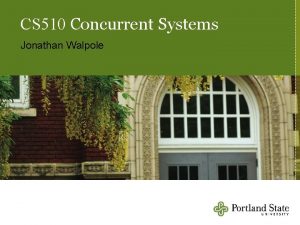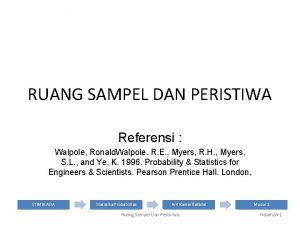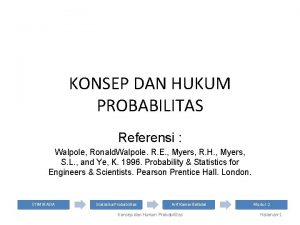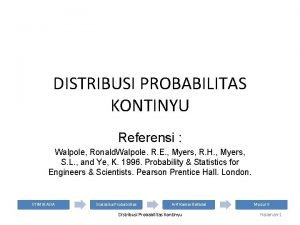CS 510 Advanced Topics in Concurrency Jonathan Walpole


















- Slides: 18

CS 510 Advanced Topics in Concurrency Jonathan Walpole

Hazard Pointers: Safe Memory Reclamation of Lock-Free Objects Maged M. Michael

The Problem - Lock-free algorithms assume that threads can operate on any object at any time - Freeing memory could break this assumption - How can we free memory of deleted nodes in a safe and lock-free manner?

Prior Work - No reuse Recycling of constant static storage Type safe memory Reference counts with DCAS or CAS 2

Goals of Hazard Pointers - Readers inform writers of references they hold - Bound the number of unreclaimed objects - Tolerance for thread failures (wait-free) - No special hardware or kernel support needed - Suitable for user or kernel use

Hazard Pointers Each thread has a set of Thread 0 pointers that only it writes, but other threads can read Each pointer is either null or points to an object the thread is currently using Before accessing any dynamic object a thread Objects must first store a pointer to it in its list 1 2 … n 6

Retired List Each thread also has a list of nodes it has deleted and would like to free When the length of this list reaches R, the thread scans the hazard pointer lists of all other threads to see if its safe to free any of its nodes. HP – Thread 2 HP – Thread 3 Ret. Nod Thread 1 7

The ABA Problem Process 1 has a copy of a pointer to Object x Process 2 deletes object x, frees its memory, and reuses the same memory to create a new object y Process 1 applies CAS on the address of object x which is the same as that of object y The CAS succeeds but the object has changed! Process 1 Process 2 Pointer P Y X Object

ABA Problem Solved Process 1 has a hazard pointer to object x Process 2 deletes object x and moves object x to its retired nodes list Process 1 can still safely access object x Hazard Pointer disallows freeing the memory and hence reuse of the same memory The ABA problem cannot occur with Hazard Pointers Process 1 Process 2 Retired Nodes List Hazard Pointers X Object

Hazard Pointer Types

Retiring Nodes

Lock Free Dequeue : Data. Type(){ while true { 4: h <- Head; 4 a: *hp 0 <- h; 4 b: if (Head != h) continue; t <- Tail; 5: next <- h. next; *hp 1 <- next; 6: if(Head != h) continue; 7: if(next == null) return EMPTY; if(h==t){ CAS(&Tail , t , next); continue; } data <- next. Data ; 8: if CAS(&Head , h , next) break; } 9: Retire. Node(h); return data; } Record Hazard Pointer for h What if h was removed b/w 4 & 4 a? Access Hazard ! What if h was freed by some thread ? ABA Hazard ! What if Head is pointing to some reincarnation of h? ABA hazard on t ! Access Hazard using next ! ABA hazard on h !

Queues

Lock Free Stack Push(data: Data. Type) { 1: node <-New. Node(); Intialising the new node 2: node. Data <- data ; while true { 3: t <- Top ; 4: node. Next <- t ; Not an Accces Hazard !! 5: if CAS(&Top , t , node) Not ABA Hazard as change of Top does not corrupt the return; Stack. !! } }

Lock Free Stack Pop() : Data. Type { While true { 6: t <- Top; 7: if (t == null) return EMPTY; 7 a: *hp <- t ; 7 b: If (Top != t) continue; 8: next <- t. Next; 9: if CAS (&Top , t , next) break; } 10: data <- t. Data ; 10 a: Retire. Node(t) ; 11: return data; } Access Hazard on t ! ABA Hazard on t!

Performance (Queues)

Conclusions Safe memory reclamation Solves ABA problem Wait-free if the original algorithm is wait-free Reasonable performance? readers must now write and these writes require memory barriers!

Stacks
 Jonathan walpole
Jonathan walpole Jonathan walpole
Jonathan walpole Advanced topics in computer science
Advanced topics in computer science Advanced c topics
Advanced c topics Cs 527 uiuc
Cs 527 uiuc Advanced topics in web development
Advanced topics in web development Angular guard naming convention
Angular guard naming convention Android advanced topics
Android advanced topics Advanced topics in angular
Advanced topics in angular Upc 2-510
Upc 2-510 Page 510 geometry answers
Page 510 geometry answers Licznik pewnego ułamka jest liczbą dodatnią
Licznik pewnego ułamka jest liczbą dodatnią Cos(510)
Cos(510) Cps 510
Cps 510 Arad=v^2/r
Arad=v^2/r Sa 510 initial audit engagement
Sa 510 initial audit engagement 510 pred kristom
510 pred kristom Nbr510
Nbr510 Alas sebuah prisma berbentuk persegi dengan luas 36 cm2
Alas sebuah prisma berbentuk persegi dengan luas 36 cm2



